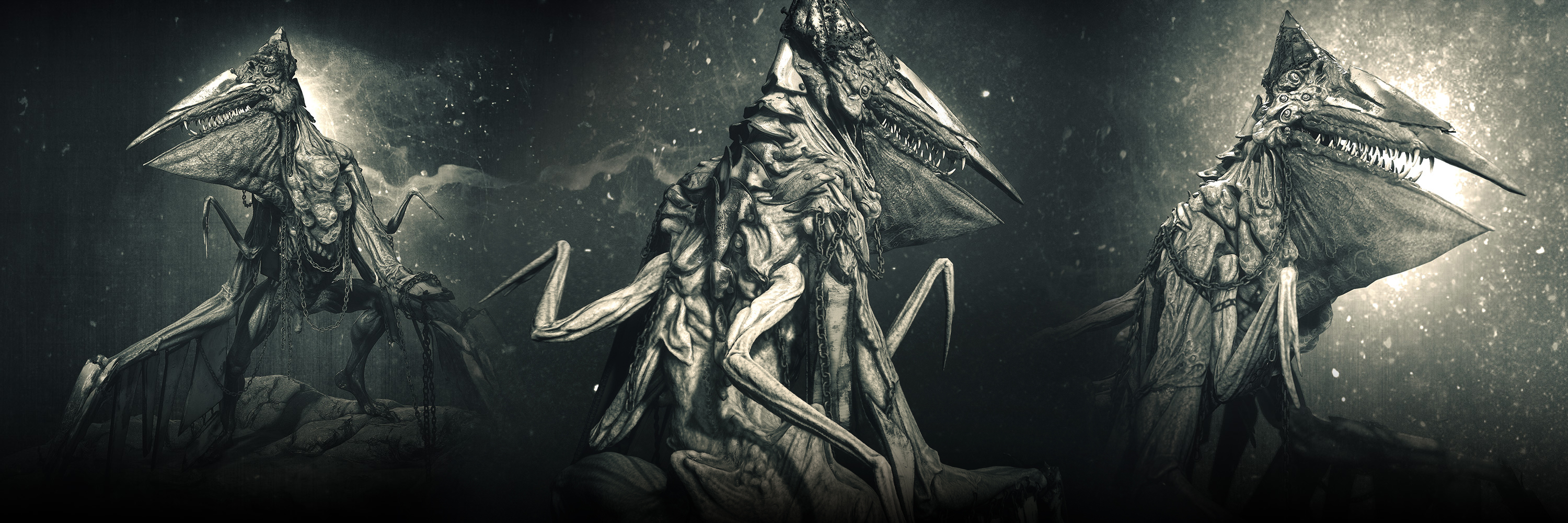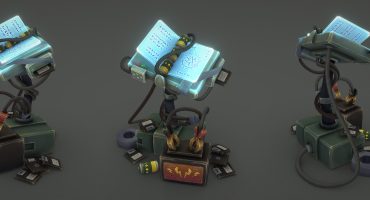Hey guys! I am Aidin, and I live in Austin, Texas, USA.
I have been painting and sculpting for more than 15 years and now I have been working as a 3D character artist in the game industry for 6-7 years. I have worked for games like Metro Exodus, Wasteland 3, and Expeditions: ROME.
I have loved video games since I was a child, so every morning I wake up with a great passion to live my childhood dream and come to my desk!
Let me tell you about fear and the charm of fear.
Things that excite us and speed up our blood circulation are attractive to us. “Humans are said to be addicted to adrenaline because of their desire to hunt, which they inherited from their early ancestors”. I heard it in a documentary and I’m not sure about it but it makes sense.
Our interest in the horror genre of movies or games seems to start here. But that’s not my reason for being interested in the horror genre.
I am interested in this genre for a completely different reason. Creativity!
The vast boundaries of creativity and diversity in the creatures of this genre are one of my main reasons for creating scary creatures and things. Symbolism and the hidden mysteries of horror ideas are other reasons for this interest.
Undoubtedly, one of the best examples of this genre that has been created in the game industry is Silent Hill!
A simple story was written based on human suffering, but with the most complex examples and the most creative ideas, it has become one of the best.
Years ago, when I was playing Silent Hill as a teenager, I was fascinated by this game’s allegories and metaphors. Each time I played, I spent hours with pen on paper, drawing characters and trying to create new ones.
This game is probably one of the most important reasons that I entered the game industry as a character designer.
I’m almost an experienced user of Sketchfab. I have won some of the Sketchfab challenges and every once in a while, I create a special piece on this amazing website. As an artist, I always enjoy this progress. Sharing works to see reactions and read feedback as well as seeing the great work of other users from around the world is really enjoyable.
How did I design it?
I always start with a basic idea. Something like a simple interest or inspiration. And then I say: I want to make a new monster!
I usually envision images of what I want to make first and then my blood boils! My eyes turn red and I go hunting for my new monster like a witcher.
According to my initial idea, I start finding references. For example, for Hummer’s King, my main idea was to upgrade one of the Silent Hill sub-characters and make a scarier and bigger monster out of it.
I also wanted to see this monster in VR because I think it feels so much more real and, of course, scarier.
I chose a creature named Hummer that I had seen before in Silent Hill: The Room and The Arcade. Hummers appear as small, black mixtures between hummingbirds and bats. Their bodies are much like that of a bat, though they have long, needle-like beaks similar to those of hummingbirds.
I thought, what if I make it bigger and take away its ability to fly? Yes, that’s the king of the hummers.
But I also wanted to make another direct reference to Silent Hill. So I added one of the famous characters of the series to my concept: Pyramid Head.
I researched the Pyramid Head design and found an old version that had included bolts attached to his helmet.
So, now I had the Hummer creatures, Pyramid Head with bolts, and a rough idea about the size and shapes.
I designed some of these ideas in 2D. I selected one of them and started to create it in 3D.
Sketchfab and VR
I wanted to present this in VR so that others would feel the shock of encountering it in VR. So, I decided to publish it on Sketchfab.
Sketchfab is a great platform for simple 3D file sharing in VR. So I set up my pipeline for that.
Modeling and texturing
After that, I started modeling block out in VR with Adobe Medium, which is a free VR sculpting tool. Sculpting in VR is very cool and it creates more creative ideas in my mind. This process helped me a lot to choose the forms and scales better. I worked on the silhouette and examined all the forms from different angles.
I sculpted the base model in VR based on the sketch.
I took the original model from VR to ZBrush to add the details.
Start in ZBrush
As a character artist, I always think about other aspects of the character I create—things like the sound of the creature, its speed of movement, or even its smell. These are important.
For example, I added hanging chains to create more movement in the animation. Also, the sound of colliding the chain together is scary. I made the hind legs smaller than the arms based on the weight of this monster.
Sculpting
As you see, he is skinny but we feel it’s very heavy. The silhouette of the body is like a pyramid—the chains and metal parts were so helpful to achieve this goal.
I always spend a lot of time in the sculpting stage for anatomy and muscle mechanisms. It’s true that the creature is based on imagination but it’s still important to incorporate realistic movement, muscles, bones, and skull. So I worked hard to achieve realism.
After finishing the base sculpt, I added all the necessary main details.
Later, I would add some small details such as bump texture in the texture section. This gives me better control over the skin bump and noise. Due to their nature, some characters need flesh, blood, wounds, and the like on their surfaces. I think these details can make the image noisy and reduce the resolution. I don’t like it. It makes everything look like a mass with a bumpy texture. So if we need good control over the amount of surface detail we can add them in texturing.
So in ZBrush, I just added large and medium details, for example, the wrinkles and large wounds.
Metal parts on the head and hands were made in the same way. Rusty iron is very prone to noise.
In some games, due to the use of grunge masks and material with bumps, we see noise everywhere in the scene. Also, the texture density of objects is important. Because, if we use different texture densities for each part of the model, it will make parts of the model look lower quality than other parts. This has a detrimental effect on the quality of the whole texture. Also whenever we have a noisy scene, the player’s eyes are tired after a short time. This eye-tiredness can prevent players from identifying important details and making quick decisions in the game. Then they leave the game.
The only way to control this problem is to remove unnecessary details. Details should be reduced to the point that image noise is removed.
It is also important that details are used based on the amount of attention they receive. For example, if we are going to draw more attention to an existing part of the body, it is better to add more details to that area.
When I was done building the model, I reduced it with ZBrush’s ZRemesher tool and then modified the topology in Maya.
It is important that you set a maximum polycount based on the size of the model and the distance from which it will be viewed. Sometimes, low topology can cause artifacts to appear in the model or animation.
In this case, I didn’t need a very low poly model.
But I needed the medium poly model for baking and controlling the unwrap and texture density.
Baking and texturing
The question is always: what size is best for texturing? 2K, 4K? How many?
I planned my textures based on the size of this character in the scene. I decided on three 4K maps for him.
The Hummer’s King is made of skin, flesh, and bones, with purulent blisters, and clad in pieces of steel and rusty iron with sharp edges, which we have seen in all of Silent Hill‘s creatures before.
So I started by creating the main skin that covers the whole body.
The polypaint I made in ZBrush was the main basis of the texture.
In Substance Designer, I made other details of the skin and blisters in order to complete the texture in Substance Painter.
Metal parts, along with their rust and damage details, were added in several layers.
But the most important part of texturing this creature was adding its emissive material. As you know, this creature was inspired by the burning hell of Silent Hill. So I had to add a melted emissive for him.
I tried to focus more on the medium shapes. After adding the emissive map layers, it was time for the final control.
I think it is very important that everything is double-checked. One of the most important things is Roughness. I always adjust the Roughnesses based on the engine I am using. Fortunately, Sketchfab is quite standard and I did not have a hard time setting up the Roughnesses.
Presentation
After finishing the textures, I tried to create a quick and simple rig in Maya so that I could put the character into a proper pose.
Rigging creatures is always a complicated task. So I left the complete rigging to a specialist in the future. My simple rig was enough for now.
I uploaded the files to Sketchfab and started in on lighting and settings.
Working in Sketchfab is really easy and I am always surprised by the result.
Some of the most satisfying settings on Sketchfab are post-processing settings. I enjoy spending time on them.
For best effect, be accurate and patiently use each and every parameter to make the scene better.
After finishing it and seeing it in VR, I was shocked.
It was so scary I could never have imagined it before.
I also tested it on Unreal Engine 5 and it was really satisfying for me.
You know, It feels great when you imagine something and then you see it up close in VR!
Well, I hope this working progress has been useful to you and encourages you to make your dreams come true—although the Hummer’s King is more of a horrible nightmare!
You can find me here.



















